The Best Philly Cheesesteak Quesadilla Recipe Ever Created
Melding two culinary classics, this philly cheesesteak quesadilla recipe bridges street food traditions with mouthwatering creativity.
Tender strips of beef sizzle alongside caramelized onions and peppers, promising an explosion of flavor.
The delicate tortilla cradles melted cheese and savory meat in every crispy bite.
You’ll fall in love with how simple ingredients can create such a remarkable fusion dish.
Rich, hearty, and packed with bold southwestern-inspired notes, this recipe transforms an American favorite into something extraordinary.
Each quesadilla delivers a perfect balance of meat, cheese, and crunch that will have everyone asking for seconds.
Why Philly Cheesesteak Quesadilla Is a Crowd Pleaser
Ingredients for Philly Cheesesteak Quesadilla
Main Protein:Vegetables:Cheese:Cooking Essentials:Wrap:How to Make Philly Cheesesteak Quesadilla
Step 1: Sear the Steak
Heat olive oil in a large skillet over medium-high heat.
Toss in the steak slices and cook until they develop a beautiful golden-brown crust, about 2-3 minutes on each side.
Carefully transfer the seared steak to a plate and set aside.
Step 2: Saute Vegetable Medley
In the same skillet, introduce the onion and bell pepper.
Sprinkle with salt and pepper to enhance their natural flavors.
Cook the vegetables until they become tender and slightly caramelized, roughly 5 minutes.
Step 3: Reunite Steak and Vegetables
Bring the seared steak back to the skillet, gently mixing it with the sautéed vegetables to create a harmonious blend of flavors.
Step 4: Prepare Cheesy Canvas
Spread out the tortillas on a clean, flat surface.
Generously scatter a combination of mozzarella and provolone cheeses over half of each tortilla.
Step 5: Assemble Quesadilla Masterpiece
Distribute the steak and vegetable mixture evenly across the cheese-covered tortilla halves.
Carefully fold the tortillas in half, creating a half-moon shape that encases the delicious filling.
Step 6: Crisp to Perfection
Clean the skillet and return it to medium heat.
Carefully place the quesadillas in the pan, cooking until they turn a gorgeous golden brown and become wonderfully crispy on both sides, approximately 3 minutes per side.
Step 7: Serve and Enjoy
Slice the quesadillas into wedges and serve immediately while they’re hot and crispy.
Prepare for a flavor explosion that combines the best of Philly cheesesteak with the classic quesadilla!
Pro Tips for Philly Cheesesteak Quesadilla
Variations for Philly Cheesesteak Quesadilla
Serving Suggestions for Philly Cheesesteak Quesadilla
How to Store Philly Cheesesteak Quesadilla
FAQs
Ribeye, sirloin, or flank steak work perfectly. Choose thin-sliced cuts for quick cooking and tender texture.
Add jalapeños or hot sauce to the steak mixture, or sprinkle red pepper flakes for extra heat.
Yes, you can prepare the steak and vegetable mixture ahead of time and assemble quesadillas when ready to eat.
Swiss, cheddar, or pepper jack cheese are great substitutes for mozzarella and provolone.
Print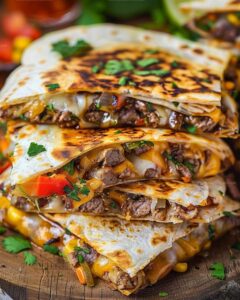
Philly Cheesesteak Quesadilla Recipe
- Total Time: 25 minutes
- Yield: 4 1x
Description
Philly cheesesteak quesadilla blends classic American sandwich flavors with Mexican-style comfort. Crispy tortillas cradle tender beef, melted provolone, and caramelized onions, offering you a mouthwatering fusion that satisfies cravings in one delicious bite.
Ingredients
Protein:
- 0.5 pounds (226 grams) ribeye steak (thinly sliced)
Vegetables:
- 1 medium onion (thinly sliced)
- 1 green bell pepper (thinly sliced)
Cheese and Tortillas:
- 1 cup shredded mozzarella cheese
- 1 cup shredded provolone cheese
- 4 large flour tortillas
Seasoning and Oil:
- 1 tablespoon olive oil
- Salt to taste
- Pepper to taste
Instructions
- Sear the steak slices in hot olive oil over medium-high heat for 2-3 minutes per side until achieving a rich golden-brown exterior. Transfer meat to a separate plate.
- Using the same skillet, sauté onions and bell peppers with salt and pepper until vegetables become soft and slightly caramelized, approximately 5 minutes.
- Reintroduce the browned steak into the skillet, gently combining with the sautéed vegetables to distribute flavors evenly.
- Arrange tortillas on a clean work surface and generously sprinkle mozzarella and provolone cheeses across one half of each tortilla.
- Distribute the steak and vegetable mixture uniformly over the cheese-covered tortilla sections.
- Carefully fold the tortillas in half, creating a half-moon shape that encases the filling.
- Clean the skillet and heat to medium, then carefully place quesadillas in the pan. Cook for approximately 3 minutes per side until achieving a crisp, golden-brown exterior.
- Remove from heat, slice into triangular wedges, and serve immediately while hot and melted.
Notes
- Slice steak against the grain for maximum tenderness and easier chewing during cooking.
- Use a meat thermometer to ensure steak reaches desired doneness without overcooking, keeping it juicy and flavorful.
- Choose thinly sliced ribeye or sirloin for authentic Philly cheesesteak texture and rich taste.
- Consider swapping traditional cheese for low-fat options or dairy-free alternatives to accommodate different dietary needs.
- Prep Time: 10 minutes
- Cook Time: 15 minutes
- Category: Lunch, Dinner, Appetizer, Snacks
- Method: Sautéing
- Cuisine: American
Nutrition
- Serving Size: 4
- Calories: 625 kcal
- Sugar: 3 g
- Sodium: 580 mg
- Fat: 38 g
- Saturated Fat: 14 g
- Unsaturated Fat: 22 g
- Trans Fat: 1 g
- Carbohydrates: 32 g
- Fiber: 3 g
- Protein: 38 g
- Cholesterol: 95 mg
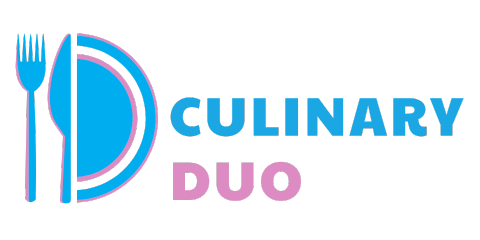
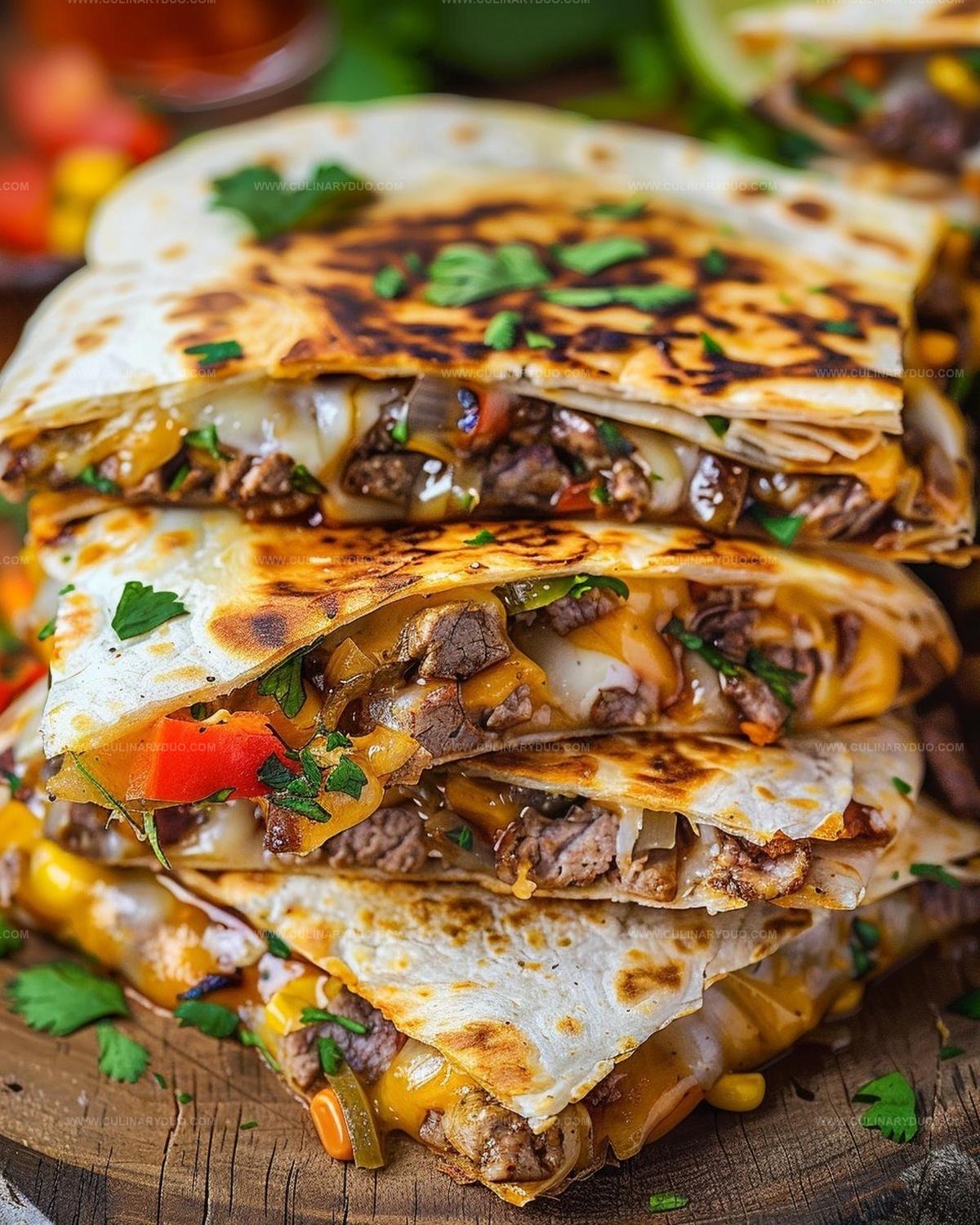
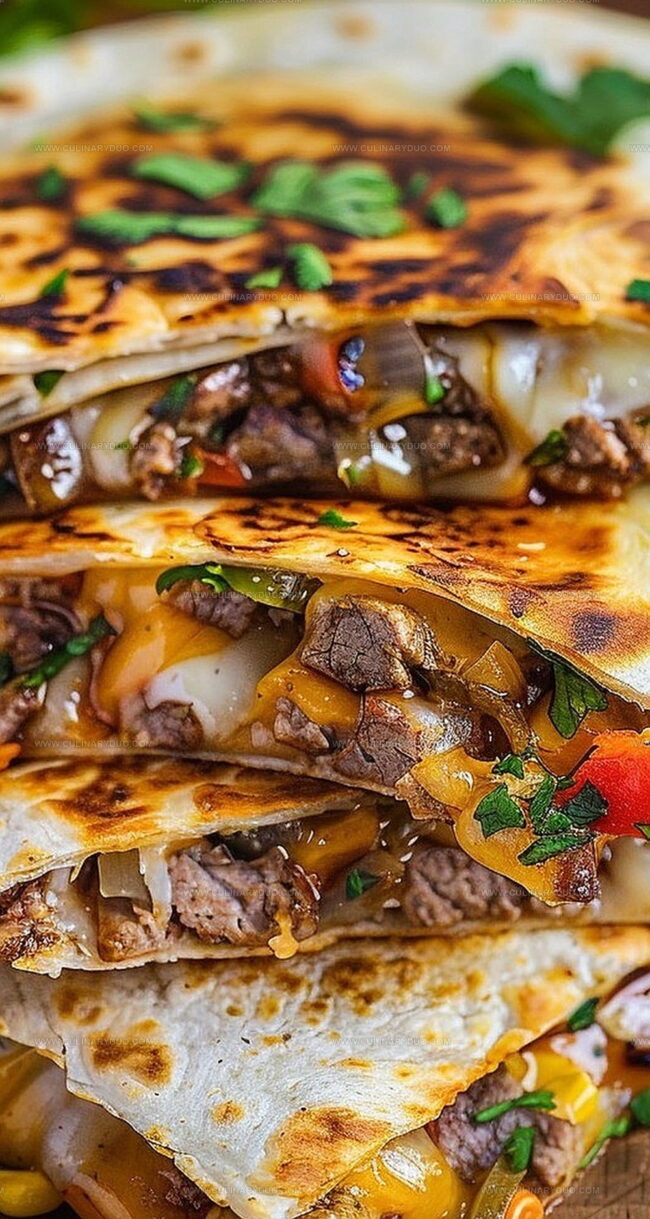
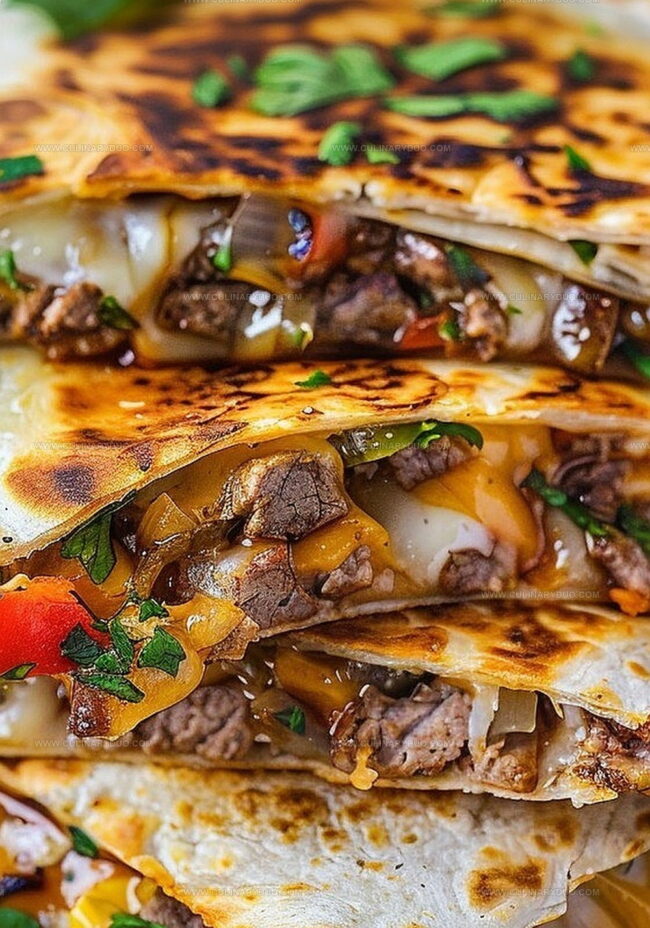
Natalie Brooks
Co-Founder & Content Strategist
Expertise
Education
eCornell
Natalie brings the vibrant, plant-powered side to Culinary Duo. After earning her Plant-Based Nutrition Certificate from eCornell, she combined her love for fresh ingredients with a passion for storytelling, aiming to make healthy cooking simple and satisfying.
Her kitchen motto: good food doesn’t need a fancy label, it just needs fresh ideas and a little creativity. Outside of writing and recipe testing, Natalie’s happiest in her garden, exploring farmers’ markets, or mixing global flavors into new kitchen experiments.